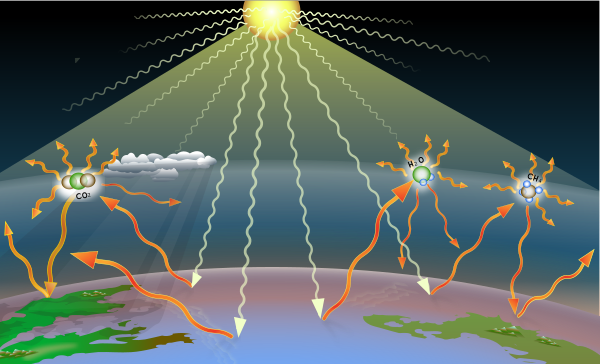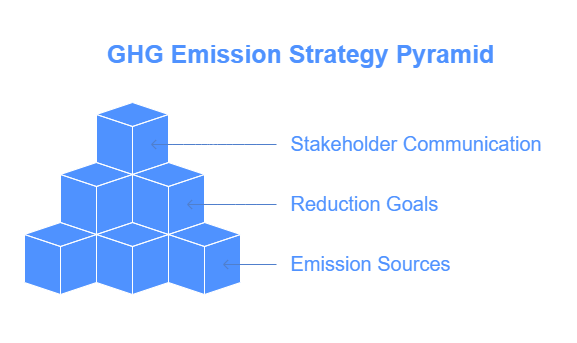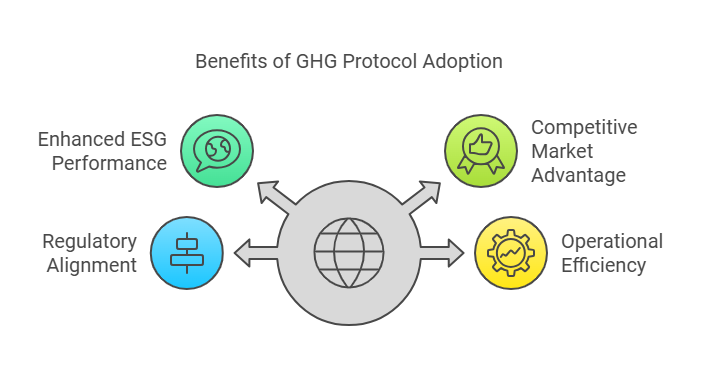Contact: +91 99725 24322 |
Menu
Menu
Quick summary: Companies must demonstrate transparency and accountability when it comes to measuring, tracking and reducing the GHG emissions. There can be no reduction in emissions without measurement standards. The Greenhouse Gas protocol (GHGP) is a comprehensive global, standardized framework for measuring and managing emissions that provides accounting and reporting

For businesses today, managing company’s carbon footprint is overwhelming, confusing, and prone to missteps, this is the reality of measuring and managing greenhouse gas (GHG) emissions in complex supply chains. Without a standardized framework, businesses risk inaccuracies, compliance failures, and even reputational damage. GHG Protocol is a global framework that provides the clarity and structure businesses need to measure, report, and reduce emissions
The Emissions Gap Report 2024 emphasizes the need for significant GHG reductions by 2030 and 2035 to meet global climate targets. The analysis examines what commitments countries need to make regarding reductions in greenhouse gas emissions in their upcoming Nationally Determined Contributions (NDCs), which must be submitted by early 2025 in preparation for COP30. A reduction of 42 percent is necessary by 2030 and 57 percent by 2035 to align with the goal of limiting warming to 1.5°C
The growing pressure from regulations and consumer demand for sustainable practices has made carbon accounting non-negotiable. By understanding and implementing this protocol, companies can not only meet compliance requirements but also build a more sustainable and transparent future.
Key Takeaways
The GHG Protocol, short for the Greenhouse Gas Protocol, is like a universal playbook for measuring and reporting greenhouse gas emissions. It helps organizations around the world understand their environmental impact, making it easier for them to take meaningful action against climate change.
The GHG Protocol was developed in the late 1990s through a collaboration between the World Resources Institute (WRI) and the World Business Council for Sustainable Development (WBCSD). These organizations wanted to create a standardized system for measuring emissions that businesses, governments, and organizations could trust and use globally.
The GHG Protocol is essential for global carbon emissions reporting. It allows businesses to establish climate goals and underpins frameworks like PCAF. Additionally, it acts as a cornerstone for regulations like the EU’s Corporate Sustainability Reporting Directive (CSRD), emerging international standards (ISSB), and forthcoming U.S. disclosure requirements.”
Before the GHG Protocol, emissions reporting was inconsistent and often unreliable. Companies used different methods, which made it impossible to compare data or track progress. The GHG Protocol changed the game by introducing a unified framework that ensures emissions are measured and reported consistently, no matter the industry or location.
Recent reports indicate that global GHG emissions per capita have slightly increased in 2022, with a notable rise of 8.3% between 1990 and 2022.
At its core, the GHG Protocol is designed to achieve three main goals:
In essence, the GHG Protocol is the foundation for reliable carbon accounting. It provides businesses with the tools to understand where their emissions come from, so they can focus on reducing them effectively. Whether you’re a multinational corporation or a small business, this protocol helps turn climate goals into actionable results.

The GHG Protocol breaks down greenhouse gas (GHG) emissions into three “scopes.” These categories help businesses identify, measure, and manage emissions from different activities.
Scope 1 covers the emissions that a company is directly responsible for—things that come from sources the company owns or controls.
Examples:
What This Means for Businesses:
If you’re running the equipment, driving the trucks, or heating your buildings, you’re creating Scope 1 emissions. These are the emissions you have the most control over and can reduce through cleaner equipment, fuel alternatives, or energy-efficient operations.
Scope 2 includes emissions from the electricity, heat, or steam that a business buys and uses. While the company doesn’t produce these emissions directly, they occur at the power plant or energy source providing the energy.
Examples:
What This Means for Businesses:
Even if you don’t own a power plant, your energy choices contribute to emissions. Switching to renewable energy sources, like solar or wind power, can significantly lower your Scope 2 emissions.
Scope 3 is the big one—it covers all the emissions that happen because of your business activities but aren’t directly under your control. These include emissions from your suppliers, customers, and the entire lifecycle of your products and services.
Examples:
What This Means for Businesses:
Scope 3 can feel overwhelming because it involves emissions outside your direct control. However, it’s also where businesses can make the most impact by choosing sustainable suppliers, designing energy-efficient products, or reducing waste in packaging.
There is a growing recognition of the importance of Scope 3 emissions, which encompass indirect emissions throughout a company’s value chain. Many companies are now reporting Scope 3 emissions to CDP annually.

The GHG Protocol might sound technical, but it’s a game-changer for businesses aiming to tackle climate change. Think of it as the rulebook that helps organizations measure and manage their greenhouse gas (GHG) emissions in a consistent, reliable, and globally accepted way.
Without a standardized system, every company could measure and report emissions differently—making it nearly impossible to compare or verify data. The GHG Protocol provides a clear framework that ensures everyone is on the same page, regardless of their industry or location.
Whether you’re a small business or a multinational corporation, consistent reporting builds credibility. Investors, regulators, and customers can trust that your data is accurate and meaningful.
The GHG Protocol isn’t just a set of rules—it’s part of the bigger picture. It helps companies align their efforts with major climate goals, like the Paris Agreement’s target to limit global warming to 1.5°C. Regulations like the EU Deforestation Regulation (EUDR) also rely on transparent emissions tracking, making the protocol essential for compliance.
Staying compliant with these global standards isn’t just about avoiding penalties—it’s about showing you’re serious about sustainability. Aligning with these goals also positions your business as a leader in the fight against climate change.
In today’s world, stakeholders expect more than promises—they demand proof. Transparent emissions reporting is a powerful way to demonstrate your commitment to sustainability. By using the GHG Protocol, you’re not just saying you care about the environment—you’re showing it with credible data.
Transparent reporting earns the trust of investors, customers, and even employees. It shows that your business isn’t greenwashing—it’s taking real, measurable action.
Understanding your emissions is the first step toward reducing them. The GHG Protocol gives you the tools to pinpoint where your emissions come from, whether it’s your energy use, supply chain, or product lifecycle. With this knowledge, you can set clear goals, prioritize high-impact changes, and even work toward achieving net-zero emissions.
Strategic decisions about emissions reduction can lower costs, boost efficiency, and future-proof your business. It’s not just good for the planet—it’s good for your bottom line.
The GHG Protocol is more than just a guide for measuring emissions—it’s a foundation for businesses to take meaningful climate action. By adopting its framework, companies can stay ahead of regulations, build stronger relationships with stakeholders, and make smarter, more sustainable decisions.
Taking care of the planet is no longer optional, and the GHG Protocol is the compass that points businesses in the right direction.

Each of the GHG Protocol standard addresses a unique need for various situations. These could be Long-term emission reduction projects, Corporate level emissions, Reporting of emissions at other places.
The GHG Protocol for Corporate Accounting and Reporting Standard is meant for companies preparing a corporate level GHG emissions inventory. This standard provides instructions and recommendations for companies top build effective strategies to reduce GHG emissions and the gaps and increase transparency and standardization.
The GHG Corporate Accounting and Reporting Standard provides the guidance for GHG accounting principles , inventory scopes, GHG emission sources, base year and tracking and monitoring of emissions.
Cities are responsible for 75 % of global carbon emissions and represent a significant chance to reduce carbon emissions and tackle climate change. The global Protocol for Community- Scale GHG Emission Inventories (GPC) is a comprehensive reporting and accounting framework for GHG emissions in cities. It allows consistent and transparent measurements of GHG emissions within cities, allowing for scaling to national levels. It supports benchmarking across regions.
The GHG Mitigation Goal Standard provides instructions for devising national and sub national mitigation goals to evaluate and report progress towards the achievement of goals. It helps to follow up on the actions and policies chalked to reduce GHG emissions and help governments reach targets and report to international organizations. It supports countries in achieving their Nationally Determined Contributions (NDCs) as signatories of Paris agreement.
The GHG Protocol Corporate Value Chain (Scope 3) Standard sets out the guidance to assess GHG emissions of their entire value chain and identify the hot spots. It helps to look at emissions outside the organization. 80 % of the corporate emissions fall into this category. The tracking and monitoring of these emissions are complex. The value chain emissions include those that result from production, transportation or use of corporate’s product or service.
GHG Protocol Policy and Action Standard sets out a standard framework for evaluating effectiveness of policies and actions. It helps governments to assess the improvements required to reduce GHGs and build effective strategies with a better understanding. It helps policy makers to compare and understand the regulations, laws, carbon taxing and other pricing mechanisms in a standardized format.
The GHG Protocol Product Life Cycle Standard looks at the full life cycle of a product to identify where the highest emissions take place and where there is a great potential to remove them. This standard streamlines the production process, reduces costs and removes risks thereby providing companies the competitive edge.
Life cycle analysis estimates the environmental impacts of a product across the entire life cycle from production to decomposition.
This has helped organizations to have lower carbon footprint and make design changes to reduce emissions
The GHG Protocol Project Accounting is a comprehensive accounting tool to help organizations quantify the benefits of climate change mitigation projects It helps to provide methods for reporting GHG reductions from such projects. Project developers, administrators, designers and programs that incorporate GHG projects can use this standard. The carbon accounting is rigorous and needs to be verified and this standard provides the necessary framework.
One of the biggest hurdles businesses encounter is gathering accurate emissions data, especially for Scope 3 emissions. These are the indirect emissions that come from your entire value chain—everything from your suppliers to how your products are used and disposed of. Since you don’t directly control most of these sources, collecting data can be like piecing together a puzzle with missing pieces. Suppliers and other partners in your value chain may not track their emissions in the same way, or at all. And, without a uniform system, it’s hard to ensure that the data you do get is reliable. This makes it difficult to get a full and accurate picture of your overall emissions.
To get a full view of your Scope 3 emissions, you need your suppliers and partners to actively participate in emissions reporting. But getting them to do so can be challenging. Some may not see the value, while others might not have the systems or resources in place to collect and report their emissions data. Even when suppliers are willing, there’s the issue of trust. Companies need to ensure that the data they receive from their partners is credible and consistent. It’s a lot of coordination and can involve educating partners about why emissions reporting matters and how it helps everyone.
Not every industry has the same tools, technologies, or approaches to emissions reporting. This lack of standardization can make it difficult for businesses to compare data across different suppliers, industries, or regions. It’s like trying to fit puzzle pieces together when the pieces don’t match. When industries don’t share the same systems or standards, it leads to inconsistent data collection methods. Businesses can’t always be sure they’re comparing “apples to apples,” making it harder to accurately assess their emissions. This can slow down progress and make decision-making more complicated.
Technology plays a key role in helping businesses comply with the GHG Protocol and tackle their sustainability goals. By embracing modern tools, businesses can ensure that they not only track emissions accurately but also simplify the entire process. Let’s take a closer look at how these technologies, like blockchain and Digital MRV (Measurement, Reporting, and Verification) platforms, are transforming GHG protocol compliance.
Blockchain is more than just a buzzword—it’s a powerful tool that can help businesses achieve accurate, reliable, and transparent emissions data tracking. Blockchain is essentially a decentralized digital ledger that records transactions across many computers, ensuring that data is not altered or tampered with.
For businesses, blockchain can be used to track and record emissions data at each step of the supply chain. When you have multiple suppliers and partners, blockchain ensures that the data collected is tamper-proof and transparent. This level of security is crucial for proving your emissions data is accurate and trustworthy, especially when you need to report it to stakeholders or regulatory bodies.
Imagine tracking a product from the moment it’s created to when it reaches the end consumer—blockchain allows for this level of transparency, making it much easier to ensure your emissions data is accurate and complies with the GHG Protocol. The benefits? Less guesswork, more trust, and no room for errors.
Digital MRV platforms are another game-changer when it comes to GHG Protocol compliance. These platforms streamline the process of measuring, reporting, and verifying emissions. They gather data from various sources, analyze it, and generate reports that can be used for compliance purposes.
One of the main challenges businesses face when tracking emissions is dealing with large amounts of data and ensuring it’s accurate and consistent. Digital MRV platforms help solve this by automating the data collection and reporting process. They can pull in data from your suppliers, manufacturing processes, and even environmental sensors, then consolidate it into easy-to-understand reports. These reports not only help businesses track their emissions but also ensure that they meet the standards set by the GHG Protocol.
TraceX’s Digital MRV (DMRV) platform is designed to simplify and streamline the process of measuring, reporting, and verifying carbon emissions data. It allows businesses to track emissions across their entire supply chain in real-time, ensuring that the data is accurate, transparent, and aligned with global standards like the GHG Protocol.
By leveraging advanced technologies such as blockchain, TraceX ensures that the emissions data is immutable and secure, reducing the risk of errors or manipulation. The platform automates data collection and reporting, making it easier for businesses to comply with regulatory requirements, reduce their carbon footprint, and work towards sustainability goals.
In essence, TraceX’s DMRV platform helps businesses meet compliance requirements, improve transparency, and drive actionable insights for emissions reduction—all while saving time and resources.
The GHG Protocol, widely regarded as the global standard for greenhouse gas (GHG) accounting, is undergoing a significant revision to ensure its continued relevance in a rapidly evolving regulatory and environmental landscape. This update aims to enhance the clarity, consistency, and applicability of the standards, enabling businesses to report emissions more accurately and transparently.
The revision of the GHG Protocol is driven by the need to address emerging challenges in carbon accounting, including complexities in Scope 3 emissions (indirect emissions across the value chain) and the growing demand for more granular, actionable data. Additionally, as the world pushes towards net-zero goals and more stringent climate regulations, the GHG Protocol needs to adapt to help businesses stay compliant and competitive. The GHG Protocol’s revision process will involve public consultation, which offers stakeholders the opportunity to contribute feedback and suggestions. The draft standards are expected to be released in 2025, and stakeholders—ranging from corporate entities, industry groups, policymakers, and environmental organizations—will have a chance to provide input on the revisions.
The GHG Protocol is a global standard for measuring and managing greenhouse gas emissions. It divides emissions into three scopes: Scope 1 (direct), Scope 2 (indirect from energy use), and Scope 3 (all other indirect emissions in the value chain).
The GHG Protocol provides businesses with a structured and consistent approach to carbon accounting, ensuring accurate emissions reporting. It helps with regulatory compliance, improves transparency, and supports sustainability initiatives.
Technology solutions like blockchain and Digital MRV (Measurement, Reporting, and Verification) platforms enable businesses to track emissions data in real-time, ensuring transparency and accuracy. These tools simplify the reporting process and enhance compliance with the GHG Protocol.
